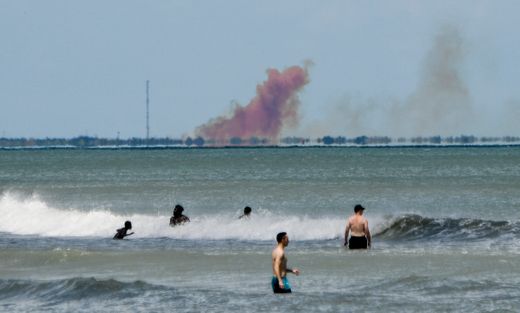
A SpaceX Crew Dragon capsule suffered an anomaly during an engine test firing at Cape Canaveral Air Force Station on Saturday afternoon, company and 45th Space Wing officials confirmed.
“On April 20, 2019, an anomaly occurred at Cape Canaveral Air Force Station during the Dragon 2 static test fire,” Wing Spokesman Jim Williams told FLORIDA TODAY. “The anomaly was contained and there were no injuries.”
FLORIDA TODAY photographer Craig Bailey, covering a surf fest in Cocoa Beach, captured an image of orange plumes rising from SpaceX facilities at the Cape around 3:30 p.m. Unconfirmed reports indicated the capsule was nearly destroyed.
“Earlier today, SpaceX conducted a series of engine tests on a Crew Dragon test vehicle on our test stand at Landing Zone 1 in Cape Canaveral, Florida,” SpaceX said in a statement. “The initial tests completed successfully but the final test resulted in an anomaly on the test stand.”
“Ensuring that our systems meet rigorous safety standards and detecting anomalies like this prior to flight are the main reasons why we test. Our teams are investigating and working closely with our NASA partners,” the company said.
SpaceX’s Crew Dragon, also referred to as Dragon 2, is designed to take humans to the International Space Station and successfully flew for the first time in March. The company was planning to launch a crewed version of the spacecraft no earlier than July, but was also planning an in-flight abort test, or a demonstration of its life-saving abort capabilities, sometime before then.
It is unknown which Crew Dragon was involved in the Saturday anomaly, but each spacecraft has Super Draco thrusters designed to be used as a launch abort system. All SpaceX engines require occasional test firings to evaluate readiness and performance.
SpaceX’s timeline to return crews to the ISS from U.S. soil will now likely be modified as the investigation into the incident continues






















